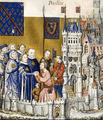Feudalism facts for kids
Feudalism was a special way of organizing society in the Middle Ages. It was all about land ownership and duties. In this system, the king owned all the land. But he would let important people, called lords or nobles, use parts of it. These lords had to promise to fight for the king and be loyal to him. The land given to them was called a fief.
Contents
How Feudalism Worked
In feudal times, people did not pay taxes with money. Instead, they paid with goods and services. Vassals, who were people given land by lords, had to give presents and taxes to their lords. For example, at harvest time, they gave a share of their crops. They also ground their grain at the noble's mill and gave part of it to the lord. When animals were killed for food, some of the meat went to the lords. In return, the lords promised to keep their vassals safe and peaceful.
The Nobles' Role
Nobles completely owned large areas of land called manors. These manors were passed down from one generation to the next. Usually, the noble's oldest son inherited everything when his father died. Each manor had its own fields for animals, a mill, a wine press, a church, and a village. Many people lived and worked on these manors. Lords gave their servants food and a place to sleep, but they did not pay them with money.
Life as a Villein
The villein was a poorer person in feudal society. They had to work for the lord or the town. But they were somewhat free in other ways. After their work, they went back to their small homes. These homes often had dirt floors and roofs made of straw. Inside, villeins hung meats, tools, and dried vegetables on the walls.
Villeins were more free than slaves or serfs, but they were not completely free. They needed the lord's permission to move or to get married. They also could not leave the manor lands without the lord's approval. If a villein escaped to a town, they could try to live quietly. If they stayed hidden for a certain time, they could become a free person. If they wanted to join the Catholic Church, they needed special permission. Joining the church could help them improve their position in society.
The Serfs' Lives
The serf was in the lowest class of feudal society. They were only a little better than slaves. A serf could not be sold away from the land. However, they were always sold with the land if it changed owners.
Both villeins and serfs had some rights. They could grow grain and vegetables to sell. The lord also had a duty to protect them. He had to provide them with land to farm. If they became wealthy enough, they could buy their freedom from the lord. Serfs and villeins did not have to serve in the army. They also did not pay state taxes. They usually paid 10% of their income to the Church. They also paid 10% to their feudal lord. This payment was called a tithe.
Images for kids
-
Investiture of a knight (miniature from the statutes of the Order of the Knot, founded in 1352 by Louis I of Naples).
-
Herr Reinmar von Zweter, a 13th-century Minnesinger, was depicted with his noble arms in Codex Manesse.
See also
 In Spanish: Feudalismo para niños
In Spanish: Feudalismo para niños







